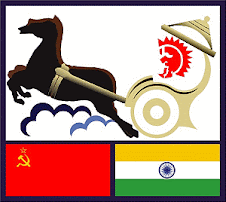Soyuz T-11 was the 6th expedition to Salyut 7, and carried the first Indian cosmonaut to the Salyut 7 station.
Crew Members : Total 3 members were carried.
Names of the Cosmonauts :
1. Yuri Malyshev (2) - Commander
2.Gennady Strekalov (3) - Flight Engineer
3. Rakesh Sharma (India) (1) - Research Cosmonaut
Number in parentheses indicates number of spaceflights by each individual prior to and including this mission.
Mission highlights :Rakesh Sharma conducted an Earth observation program concentrating on India. He also did life sciences and materials processing experiments.
Date/Time of Launch : April 3, 1984 Time : 13:08:00 UTC
Place of Launch : Baikonur Cosmodrome LC31 Launch pad
Where did the Crew Stay and Where was Soyuz T-11 Docked ?The crew stayed in Salyut 7 Space Station (one of the space stations built by Russia). Soyuz T-11 was docked to the space station.
Duration : the crew spent 7 Days 21 Hours 40 Minutes.
How did they Return to Earth?The Crew members including Rakesh Sharma returned earth using Soyuz T-10 on 11th April 1984 at 10:48:48 UTC instead of Soyuz T-11 which brought them .
Soyuz T-10 (with 3 member Crew) was launched on February 8, 1984 12:07:26 UTC prior to Soyuz T-11. Soyuz T-10 was kept docked to space station since Feb,1984.
For Details of Soyuz T-10, its crew and when they returned click here.
Interesting thing : By the time Rakesh Sharma was to reach Salyut 7 space Station on 3rd April,1984 in Soyuz T-11. A crew consisting of
1. Leonid Kizim (2) - Commander
2. Vladimir Solovyov (1) - Flight Engineer
3. Oleg Atkov (1) - Research Cosmonaut
were already present since 8th February 1984. They were brought to the station using Soyuz T - 10 . However they returned home only on 2nd October 1984.
To know what crew of Soyuz T-10 did click here.
Other Info :Mission parameters
• Mass: 6850 kg
• Perigee: 195 km
• Apogee: 224 km
• Inclination: 51.6°
• Period: 88.7 minutes
Like any other Manned mission. This mission had a backup crew to replace the first selected members of the crew (before launch). Replacement would take effect incase of ill health or any other reasons deterimental to space flight of a crew member.
Backup crew• Anatoli Berezovoy - Commander
• Georgi Grechko - Flight Engineer
• Ravish Malhotra (India) - Research Cosmonaut







